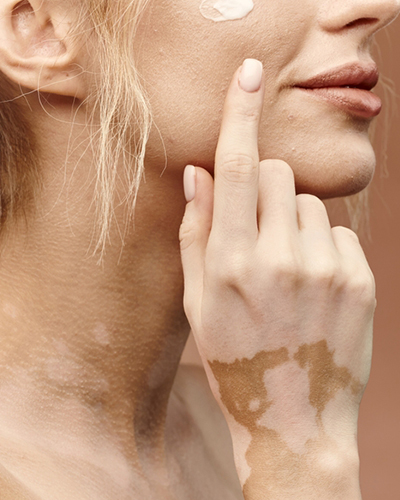
Vitiligo is a chronic skin condition characterized by the loss of pigment, resulting in light-colored patches on various parts of the body needing Vitiligo Treatment in Kukatpally. This occurs when melanocytes, the cells responsible for producing melanin—the pigment that gives skin its color—are destroyed or malfunction. The exact cause of vitiligo remains unclear as per Skin Pigmentation Specialist in Kukatpally, but it is believed to involve autoimmune mechanisms, where the immune system mistakenly attacks these pigment-producing cells. Vitiligo can affect people of all skin types, and its onset often occurs in childhood or young adulthood, although it can develop at any age. The condition’s progression is unpredictable; some individuals may experience small areas of depigmentation, while others can endure larger patches that spread over time. Although vitiligo is not physically harmful or contagious, it can significantly impact self-esteem and psychological well-being due to its visible nature. Treatment options range from topical corticosteroids and phototherapy to cosmetic solutions like skin dyes and makeup. While there is currently no cure for vitiligo, ongoing research aims to better understand its mechanisms and develop effective treatments to restore skin pigmentation.
Who is at risk of vitiligo ?
- Family History: Individuals with a family history of vitiligo or other autoimmune diseases are more likely to develop it.
- Autoimmune Disorders: Those with autoimmune conditions such as thyroid disease, alopecia areata, or rheumatoid arthritis have an increased risk.
- Age: Vitiligo can occur at any age but often begins in childhood or young adulthood.
- Skin Type: People with darker skin may experience a more noticeable contrast with the loss of pigmentation, though the condition affects all skin types.
- Sunburn History: Individuals who have experienced severe sunburns are at higher risk of developing vitiligo.
- Environmental Factors: Exposure to certain chemicals or skin trauma, including cuts or severe sunburns, can trigger the onset of vitiligo.
- Stress: Emotional stress is believed to contribute to the condition's development or worsening.
- Gender: Some studies suggest that women may be at slightly higher risk than men, although it can affect anyone regardless of gender.
- Ethnicity: While vitiligo can occur across all ethnicities, it is more visible in individuals with darker skin, leading to greater concern and awareness in those populations.
Age and Vitiligo
Yes, vitiligo can occur at any age as per Dermatologist in Hyderabad, although it most commonly appears in people between the ages of 10 and 30. It is an autoimmune condition that leads to the loss of skin pigment, resulting in white patches. While the exact cause of vitiligo remains unclear, factors such as genetics, environmental triggers, and stress may contribute to its onset. In some cases, vitiligo can develop suddenly, while in others, it may progress gradually over time. It is important for individuals experiencing symptoms at any age to seek advice from a healthcare professional for proper diagnosis and management options.
Different treatment options by Best Skin Doctor in Kukatpally :
- Topical Corticosteroids: Often the first line of treatment, these can help reduce inflammation and stimulate repigmentation in affected areas.
- Calcineurin Inhibitors: Medications like tacrolimus and pimecrolimus are used for sensitive areas and may be effective in promoting skin color restoration.
- Phototherapy: Narrowband UVB therapy is commonly employed to encourage repigmentation, often requiring multiple sessions.
- Excimer Laser: This targeted treatment can effectively treat localized vitiligo, especially in small patches.
- Depigmentation Therapy: In cases with widespread vitiligo, skin-lightening agents may be used to even skin tone by depigmenting unaffected areas.
- Surgical options: Skin grafting and melanocyte transplantation are considered for stable vitiligo when other treatments are ineffective.
- Supportive Care: Sunscreen, cosmetics, and counselling by Dr. Sri Chaitanya Reddy can help improve the quality of life for those with vitiligo.

